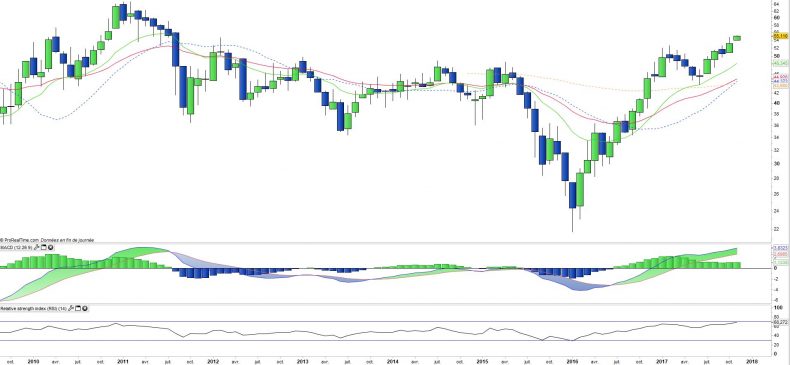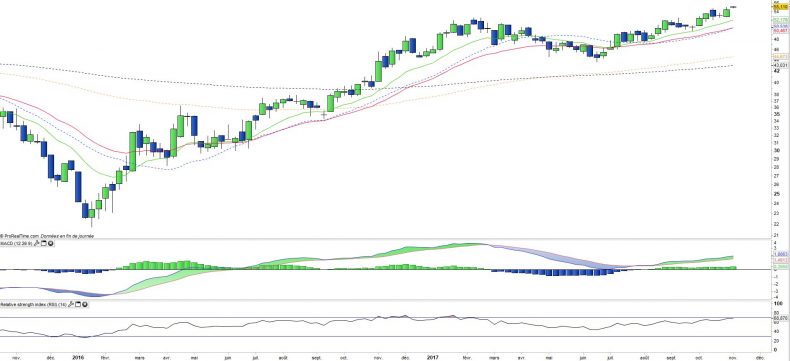Lyxor ETF Basic Resources - BRE - 07/11/2017
Short Term strategy : Positive (100%) / Trend +
Long Term strategy : Positive (100%) / Trend +
Characteristics of the ETF
The ETF Lyxor BRE (Basic Resources UCITS Europe) created in 08/2006 is listed in Euro on Euronext and seeks to replicate the index STOXX600 Basic Resources Europe composed of 22 European stocks of which about 2/3 are English, which implies a significant risk related to the Euro – Sterling evolution which can be quite volatile in this period of Brexit.
The costs of this ETF are 0.3% and the AUM of approximately 270M€. Replication is indirect (via Swap) and dividends are capitalized. This ETF is eligible for PEA.
Alternative ETFs: EXV6 (Ishares in Euro)
Index & components
This is a fairly narrow index composed of 22 major mining companies, mostly English. The 3 largest mining companies, Rio Tinto, BHP Billington and Glencore account for almost 50% of the weighting of the index and are quoted in £ on the LSE. They are diversified mining companies (iron ore, copper, coal ...) with market capitalizations included in € 50 and € 75bn. These companies are listed on European markets (especially London) but mining operations are most often located in Africa, Australia or the Americas.
After five difficult years (2011-2015), commodity prices started to recover in 2016, due to Chinese capacity reduction announcements (mainly steel and aluminum) and a surge of optimism around the world. Donald Trump's victory in the US presidential elections, tied to the promise of a major infrastructure program, as key triggers. The evolution of the prices of the main ores was rather favorable in 2017 for a certain number of metals (aluminum, copper, Nickel, Palladium ...) because of a reduction of the overcapacities coming from China, and growth themes like the electric car and renewable energies. The current demand is also largely due to China's monetary support for its economy (real estate / construction in particular), in a particular political context (renewal of Mr. XI by the CCP) and can therefore seem a bit fragile. Diversification is at the heart of the strategy of the major mining companies who wish rather to develop capacities in the sectors of the future (Aluminum, Copper ...) and to reduce them in sectors in difficulty (Coal ...). The sector depends on two main factors, namely demand, especially for infrastructure and the industrial sector (construction and automotive), mainly from China and the US, but also from Europe and major emerging countries such as India, but especially of the supply side so far plethoric.
The scenario of a drastic decline in Chinese capacity does not seem to be on the agenda, especially in iron ore, but the introduction of the US import tax on certain metals (aluminum) could incite China to more discipline on its supply policy. BRE remains a rather volatile medium, which is very sensitive to variations in demand but also to supply adjustments.
Latest developments
After a very strong increase of 64.5% in 2016, BRE continues its progression in 2017, with an increase of 20.9% which is significantly higher than that of the Stoxx600NR (12.5%).
The rebound of commodities is due to the reduction of certain overcapacity in China, which aimed to reduce pollution, make the most modern smelters more profitable and lower tensions with the West. In addition, the theme of reflation of the world economy through the tax reduction plan of D. Trump and a possible US infrastructure plan, the current European recovery and Chinese recovery plans, is positive for the materials and for the mining sector, which explains the good recent performance.
Some increases in minerals such as copper or aluminum and indeed rare earths seem more structural and related to growth themes such as the electric car, batteries or the electronics industry. In addition, coal has been rising sharply since the summer, which should support business results and help optimize portfolios by selling assets.
Major mining groups also benefit from significant operational leverage after conducting a number of mine closures in deficit over the last 3 years.
Monthly data
The monthly chart shows a long-term trend that has returned to a clear positive path in 2017. Important positive factor: the strong resistance of the €50 active since 2012 has been crossed this summer, which considerably strengthens the bullish technical profile. All the indicators are positive and the next technical objective is represented by the summit of summer 2011 located in the 65 € zone.
The RSI is at the highest historical level, which expresses the current strength of the movement which represents more than a rebound.
Weekly data
On the weekly chart, we can see that the trend has returned bullish on the medium term horizon from the beginning of 2016. The trend was on a pause mode in the 2nd quarter of 2017, but a new bullish wave appears in full development with as the first step the overtaking of the peak of the year which has just intervened.
The oscillators are far from overbought and the upward potential of this impulse does not seem exhausted at all.
.
ETF Objective
BRE is a UCITS compliant ETF that seeks to replicate the benchmark index Stoxx Europe 600 Basic Resources Net Return (20 companies)
Characteristics
| Inception date | 25/08/2006 |
| Expense ratio | 0,3% |
| Benchmark | Stoxx600 Basic Resources Net Return |
| Issuer | Lyxor |
| Ticker | BRE |
| ISIN | FR0010345389 |
| UCITS | Yes |
| EU-SD Status | Out of scope |
| Currency | € |
| Exchange | Euronext |
| Assets Under Management | 270 M€ |
| Replication Method | Indirect (via a swap) |
| Dividend | Capitalization |
| PEA (France) | Yes |
| SRD (France) | Yes |
| Currency Risk | Yes (£/€) |
| Number of Holdings | 20 |
| Risk | 4/5 |
Country Breakdown
| United Kingdom | 22% |
| Switzerland | 21% |
| Australia | 14% |
| Finland | 10% |
| Luxembourg | 9% |
| Sweden | 6% |
| Norway | 4% |
| Jersey | 4% |
| South Africa | 3% |
| Others | 7% |
Sector Breakdown
| Materials | 96% |
| Energy | 2% |
| Consumer staples | 2% |
Top Ten Holdings
| Glencore Xstrata | 21% |
| Rio Tinto | 15% |
| BHP Billiton | 14% |
| Anglo American | 7% |
| ArcelorMittal | 7% |
| UPM-Kymmene | 6% |
| Norsk Hydro | 4% |
| Boliden | 3% |
| Stora Enso | 3% |
| Randgold Resources | 3% |


